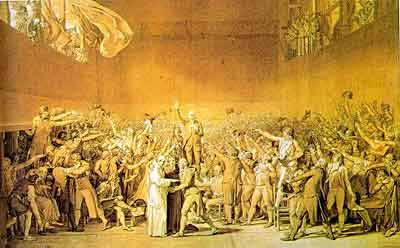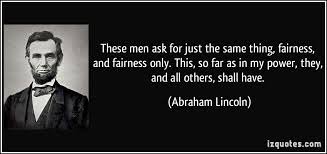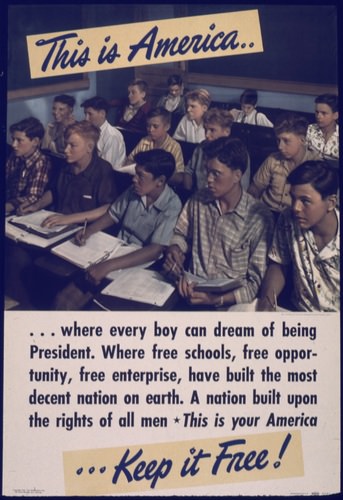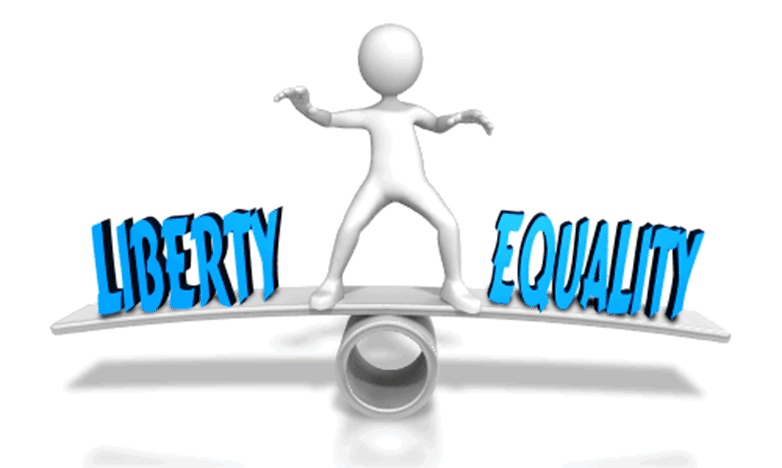2.7: Unalienable Rights
- Page ID
- 5830
\( \newcommand{\vecs}[1]{\overset { \scriptstyle \rightharpoonup} {\mathbf{#1}} } \)
\( \newcommand{\vecd}[1]{\overset{-\!-\!\rightharpoonup}{\vphantom{a}\smash {#1}}} \)
\( \newcommand{\dsum}{\displaystyle\sum\limits} \)
\( \newcommand{\dint}{\displaystyle\int\limits} \)
\( \newcommand{\dlim}{\displaystyle\lim\limits} \)
\( \newcommand{\id}{\mathrm{id}}\) \( \newcommand{\Span}{\mathrm{span}}\)
( \newcommand{\kernel}{\mathrm{null}\,}\) \( \newcommand{\range}{\mathrm{range}\,}\)
\( \newcommand{\RealPart}{\mathrm{Re}}\) \( \newcommand{\ImaginaryPart}{\mathrm{Im}}\)
\( \newcommand{\Argument}{\mathrm{Arg}}\) \( \newcommand{\norm}[1]{\| #1 \|}\)
\( \newcommand{\inner}[2]{\langle #1, #2 \rangle}\)
\( \newcommand{\Span}{\mathrm{span}}\)
\( \newcommand{\id}{\mathrm{id}}\)
\( \newcommand{\Span}{\mathrm{span}}\)
\( \newcommand{\kernel}{\mathrm{null}\,}\)
\( \newcommand{\range}{\mathrm{range}\,}\)
\( \newcommand{\RealPart}{\mathrm{Re}}\)
\( \newcommand{\ImaginaryPart}{\mathrm{Im}}\)
\( \newcommand{\Argument}{\mathrm{Arg}}\)
\( \newcommand{\norm}[1]{\| #1 \|}\)
\( \newcommand{\inner}[2]{\langle #1, #2 \rangle}\)
\( \newcommand{\Span}{\mathrm{span}}\) \( \newcommand{\AA}{\unicode[.8,0]{x212B}}\)
\( \newcommand{\vectorA}[1]{\vec{#1}} % arrow\)
\( \newcommand{\vectorAt}[1]{\vec{\text{#1}}} % arrow\)
\( \newcommand{\vectorB}[1]{\overset { \scriptstyle \rightharpoonup} {\mathbf{#1}} } \)
\( \newcommand{\vectorC}[1]{\textbf{#1}} \)
\( \newcommand{\vectorD}[1]{\overrightarrow{#1}} \)
\( \newcommand{\vectorDt}[1]{\overrightarrow{\text{#1}}} \)
\( \newcommand{\vectE}[1]{\overset{-\!-\!\rightharpoonup}{\vphantom{a}\smash{\mathbf {#1}}}} \)
\( \newcommand{\vecs}[1]{\overset { \scriptstyle \rightharpoonup} {\mathbf{#1}} } \)
\( \newcommand{\vecd}[1]{\overset{-\!-\!\rightharpoonup}{\vphantom{a}\smash {#1}}} \)
\(\newcommand{\avec}{\mathbf a}\) \(\newcommand{\bvec}{\mathbf b}\) \(\newcommand{\cvec}{\mathbf c}\) \(\newcommand{\dvec}{\mathbf d}\) \(\newcommand{\dtil}{\widetilde{\mathbf d}}\) \(\newcommand{\evec}{\mathbf e}\) \(\newcommand{\fvec}{\mathbf f}\) \(\newcommand{\nvec}{\mathbf n}\) \(\newcommand{\pvec}{\mathbf p}\) \(\newcommand{\qvec}{\mathbf q}\) \(\newcommand{\svec}{\mathbf s}\) \(\newcommand{\tvec}{\mathbf t}\) \(\newcommand{\uvec}{\mathbf u}\) \(\newcommand{\vvec}{\mathbf v}\) \(\newcommand{\wvec}{\mathbf w}\) \(\newcommand{\xvec}{\mathbf x}\) \(\newcommand{\yvec}{\mathbf y}\) \(\newcommand{\zvec}{\mathbf z}\) \(\newcommand{\rvec}{\mathbf r}\) \(\newcommand{\mvec}{\mathbf m}\) \(\newcommand{\zerovec}{\mathbf 0}\) \(\newcommand{\onevec}{\mathbf 1}\) \(\newcommand{\real}{\mathbb R}\) \(\newcommand{\twovec}[2]{\left[\begin{array}{r}#1 \\ #2 \end{array}\right]}\) \(\newcommand{\ctwovec}[2]{\left[\begin{array}{c}#1 \\ #2 \end{array}\right]}\) \(\newcommand{\threevec}[3]{\left[\begin{array}{r}#1 \\ #2 \\ #3 \end{array}\right]}\) \(\newcommand{\cthreevec}[3]{\left[\begin{array}{c}#1 \\ #2 \\ #3 \end{array}\right]}\) \(\newcommand{\fourvec}[4]{\left[\begin{array}{r}#1 \\ #2 \\ #3 \\ #4 \end{array}\right]}\) \(\newcommand{\cfourvec}[4]{\left[\begin{array}{c}#1 \\ #2 \\ #3 \\ #4 \end{array}\right]}\) \(\newcommand{\fivevec}[5]{\left[\begin{array}{r}#1 \\ #2 \\ #3 \\ #4 \\ #5 \\ \end{array}\right]}\) \(\newcommand{\cfivevec}[5]{\left[\begin{array}{c}#1 \\ #2 \\ #3 \\ #4 \\ #5 \\ \end{array}\right]}\) \(\newcommand{\mattwo}[4]{\left[\begin{array}{rr}#1 \amp #2 \\ #3 \amp #4 \\ \end{array}\right]}\) \(\newcommand{\laspan}[1]{\text{Span}\{#1\}}\) \(\newcommand{\bcal}{\cal B}\) \(\newcommand{\ccal}{\cal C}\) \(\newcommand{\scal}{\cal S}\) \(\newcommand{\wcal}{\cal W}\) \(\newcommand{\ecal}{\cal E}\) \(\newcommand{\coords}[2]{\left\{#1\right\}_{#2}}\) \(\newcommand{\gray}[1]{\color{gray}{#1}}\) \(\newcommand{\lgray}[1]{\color{lightgray}{#1}}\) \(\newcommand{\rank}{\operatorname{rank}}\) \(\newcommand{\row}{\text{Row}}\) \(\newcommand{\col}{\text{Col}}\) \(\renewcommand{\row}{\text{Row}}\) \(\newcommand{\nul}{\text{Nul}}\) \(\newcommand{\var}{\text{Var}}\) \(\newcommand{\corr}{\text{corr}}\) \(\newcommand{\len}[1]{\left|#1\right|}\) \(\newcommand{\bbar}{\overline{\bvec}}\) \(\newcommand{\bhat}{\widehat{\bvec}}\) \(\newcommand{\bperp}{\bvec^\perp}\) \(\newcommand{\xhat}{\widehat{\xvec}}\) \(\newcommand{\vhat}{\widehat{\vvec}}\) \(\newcommand{\uhat}{\widehat{\uvec}}\) \(\newcommand{\what}{\widehat{\wvec}}\) \(\newcommand{\Sighat}{\widehat{\Sigma}}\) \(\newcommand{\lt}{<}\) \(\newcommand{\gt}{>}\) \(\newcommand{\amp}{&}\) \(\definecolor{fillinmathshade}{gray}{0.9}\)“We hold these truths to be self-evident: that all men are created equal that they are endowed by their Creator with certain unalienable Rights, that among these are Life, Liberty, and the pursuit of Happiness.” Thomas Jefferson, Preamble to the Declaration of Independence
“Inequality will exist as long as liberty exists. It unavoidably results from that very liberty itself.” Alexander Hamilton. Constitutional Debate, June 26, 1787
“Government is instituted for those who live under it. It ought therefore to be so constituted as not to be dangerous to their liberties. The more permanency it has the worse if it be a bad.” Roger Sherman, Constitutional Debate, June 26, 1787
“Four score and seven years ago our fathers brought forth on this continent a new nation, conceived in liberty, and dedicated to the proposition that all men are created equal.” Abraham Lincoln, Gettysburg Address
Overview
Natural rights are often considered unalienable, meaning that are not to be taken away or denied. English philosopher John Locke believed that “Life, Liberty, and Property were the most important natural rights. In the Declaration of Independence, Thomas Jefferson defined natural rights as “Life, Liberty, and the Pursuit of Happiness.” Both men believed that the purpose of government is to protect these rights through a social contract.
Liberty and equality-- these words have come to represent the basic values of democratic political systems including that of the United States.While rule by absolute monarchs and emperors has often brought peace and order, in many instances it has done so at the cost of personal freedoms. As we have seen, democratic values support the belief that an orderly society can exist in which freedom is preserved. However, order and freedom must be balanced.
It is the seemingly conflictual relationship between liberty and equality that has really formed the root of political conflict and debate since the origins of the first democratic governments. In this section, we will examine the basic concepts of equality and liberty and how modern democratic governments must balance the ideals of equality with the protection of basic liberties and freedoms. In other words, how can everybody be treated as equals, yet still have the freedom to own property and “pursue happiness” when those same basic freedoms may infringe upon the liberties of others?

Defining Liberty, Equality, and Justice
Liberty
While there are many definitions of liberty, they all share a common feature that is important to our political understanding. That is, the ability to do as one pleases without interference (within the confines of common rules of society and law).
Equality
Again, while there are many definitions of equality, perhaps the best way to describe the common political understanding of this word is to describe it as the degree to which people are treated the same and without being “singled out” or restricted with regard to their beliefs, nationalities, cultures, and backgrounds. Black’s Law, the most commonly used law dictionary in the United States, further defines equality as “the condition of possessing the same rights, privileges, and immunities, and being liable to the same duties.” In other words, from a legal perspective, equality means people are all given the same basic rights and privileges, as well as being held to the same requirements and responsibilities within a society.
Justice
As with liberty and equality, there are many definitions of justice, but some common features between these definitions can be seen. This commonality should lead us to an understanding of the term. These features include a set of morals and standards, a system by which people are judged and punished fairly according to a standard set of commonly understood and practiced laws, a common understanding and practice of right or moral conduct, and a standardized application of punishments if the standards or rules of a community are violated.
Does justice always mean fairness? This is a much more complicated question. For instance, it may be fair to apply laws and punishments to all citizens in the same way without considering circumstances or mitigating factors, but is it just? Do we give a four-year-old the same punishment for stealing a candy bar from a store as we would a young adult who should know better? Is someone who kills a person in the course of self-defense given the same punishment as someone who commits a “cold-blooded” murder? If truly equitable justice was the goal of government then everyone would, indeed, be treated in exactly the same way, but today we would see this not as justice but as being unfair because we often consider a number of factors in determining guilt and punishment.

Economic Arguments
Much of the conflict and debate over the relationship between liberty and equality revolves around the central economic questions of (1) what should be produced, (2) how will it be produced, and (3) for whom will it be produced? If, as John Locke proposed, people should have a natural right to the ownership of property, how can that right to property be balanced with equality? This becomes a question because not everyone will have the same amount of wealth. Just as we have seen several views of political liberty, we can examine economic wealth in the same way.
Distribution of Wealth
There are basically three approaches to the distribution of wealth.
1) Free Market Economies (Capitalism) is the belief that markets should be left alone by governments, and people should be free to make and buy what they wish at a price that is best left open to the forces of an open market. Thinkers such as Adam Smith, the Scottish philosopher and founder of modern economics theory, believed that such free market systems of exchange work to benefit both the producer and the consumer in the most efficient way by offering a variety of choices. Through the “invisible hand” of competition, the most efficient price is determined as a result of the competitive marketplace.
This system has been the root of American economic and political policy from our inception. The benefit is that people are free to make and buy what they want (given a large amount of liberty and freedom of choice), but there is an inherent understanding that, to quote the Rolling Stones, “You Can’t Always Get What You Want …” because not everyone will have the same level of wealth and income.
The counter-argument, of course, is that you are free to be as wealthy as you wish as long as you work hard and follow the rules. Others would argue that the rules do not work for everyone, particularly minorities. So, in the views of many, equality is sacrificed for the sake of economic liberty.
Here is a video (from the 1950s) on the benefit of Capitalism and distribution of wealth in the United States. It’s a little dated, but that’s part of the “charm.” How do you think these ideals apply to our society today?
Click below to watch a video on the distribution of wealth in the United States known as the “one percent problem” This video is a little lengthy, but see if you agree or disagree with the arguments presented in the video and compare them to the ideals expressed in the previous video.
(2) Socialism involves government influence and intervention in the basic economic questions: what to make, how to make it, and who will get it. Most socialist systems revolve around governmental intervention in or direct provision of goods and services. As an example, the government provided healthcare systems are often referred to as socialist by critics because they bypass the open market and require the government to provide a good or service to the public.
The primary argument against this system is that to provide those services, nations who have socialist economic policies often have very high taxes and fewer choices in the marketplace (not to mention the prices for many goods are much higher than they should be because of the lack of competition).
First, let's look at an academic explanation of pure socialism.
Next, let's take a more humorous look at the idea of "socialism."
(3) Communism involves direct governmental ownership and control of all means of production. These economies are often called command or planned economies because the government directly plans for or commands the types and quantities of goods that will be produced. They own or control the factories and workers that will produce the goods and services, and they set the price for those goods themselves (deciding who in society will be able to afford them).
These economies are most directly compared to the former Soviet Union, China, North Korea, and Cuba. While most former European communist countries (and China) have adopted a more capitalist approach to their economies, the effects of planned economies can still be seen. The criticism of these types of economic and political systems is that while there is equality (everyone is theoretically treated as an equal), the sacrifice is in freedom of choice and personal liberty. Most economic critics believe this system to be the least efficient system.
Below is a Khan Academy discussion of Communism.

The American Dream
Surely the conflict between liberty and equality is not just an economic one. Of course, there are more factors to consider in any society than simply the distribution and acquisition of wealth. However, it would seem that in the American system of government, much of the debate revolves around these economic considerations. Our nation has also been one that has considered the relationship between liberty and equality as one that also allows for equal opportunity. This approach would argue that everyone should have the same opportunity to acquire wealth and to improve their standard of living. Many would call this the “American Dream.”
The “American Dream” refers to a set of ideals in which freedom includes the opportunity for prosperity, success, and upward social mobility for the family and the children. The American Dream may be achieved through hard work in a society with few barriers. According to James Truslow Adams in his 1931 definition of the American Dream, "Life should be better and richer and fuller for everyone, with opportunity for each according to ability or achievement" regardless of social class or circumstances of birth.
The question for many of us today is “Can we still achieve the American Dream?” In a June 2014 CBS News Poll, this debate is openly discussed, with six out of ten of those people polled indicating that they believe the “American Dream” is no longer obtainable.
http://www.cbsnews.com/news/why-most-say-the-american-dream-is-out-of-reach,
http://www.cbsnews.com/news/how-to-revive-your-american-dream/
or examine a 2018 poll here:
today.yougov.com/topics/politics/articles-reports/2018/10/04/american-dream-representation
Do you agree with the polls? Why or Why not?

Balancing Liberty and Equality
Shouldn't governments help preserve some degree of equality for their citizens? If they overemphasize equality, won't they restrict their citizens' liberty? For example, governments can bring about more equality by taxing rich citizens more than the poor, but if they carry their policies too far, won't they restrict the individual's freedom to strive for economic success?
The balance between liberty and equality is an important cornerstone of democratic government. If we view this as a balance between liberties and equal opportunities, then we see what the founding fathers intended (particularly when they mentioned the pursuit of happiness. If we try to view this as a balance between freedom and equal outcomes (where everyone is exactly the same), there is a tremendous tradeoff between the two. It seems one must be sacrificed in exchange for the other.
Understanding these theories and concepts, the Founders created the blueprints for the United States government in an effort to achieve these delicate balances — between liberty and order, and between liberty and equality. Their success is reflected in the continuing efforts to refine them. The formula has changed with time, but the framework provided by the Constitution and the values expressed by the Declaration of Independence remain the same.
Study/Discussion Questions
- What tradeoffs exist between liberty, equality, and justice?
- Why do you think political scientists and economists often view the democratic ideals of liberty, equality, and justice as requiring tradeoffs? Can these democratic ideals all co-exist in their purest forms without tradeoffs between them? Why/why not?
- Describe and explain practical examples of the following tradeoffs:
- LIBERTY and EQUALITY:
- LIBERTY and JUSTICE:
- JUSTICE and FAIRNESS:
- What is meant by the term the "American Dream?" Give an example.
- Create a graphic organizer similar to the one below and complete it using your understanding and research on the three basic economic systems:
|
Economic System |
Basic Description/ Definition |
Who Decides What is Produced? |
Who Decides How it is Produced? |
Who Decides “Who Gets What?” |
Writing Assignment
What is your American Dream? What is your plan to attain it? Do you consider the American Dream an attainable objective in your generation? Why/why not?
Write an essay on the above topic. Your essay should use appropriate English language construction, punctuation, grammar, and vocabulary. In addition, show evidence of planning, including an appropriate thesis, an introduction, supporting paragraphs and a summary/conclusion.
Sources:
Definition of Liberty - http://dictionary.reference.com/browse/liberty
Definition of Equality - http://dictionary.reference.com/browse/equality
Legal Definition of Equality - http://thelawdictionary.org/equality/
Definition of Justice - http://dictionary.reference.com/browse/justice
Ethical Discussion of Justice - http://www.scu.edu/ethics/practicing/decision/justice.html
World History Crash Course Capitalism and Socialism -https://www.youtube.com/watch?v=B3u4EFTwprM
Khan Academy Discussion of Communism - https://www.youtube.com/watch?v=MmRgMAZyYN0
“The One Percent Wealth Gap” documentary - https://www.youtube.com/watch?v=HmlX3fLQrEc
Academic Explanation of Socialism- https://www.youtube.com/watch?v=shD8ZHqP_6k
Youtube Video spoofing Socialism- https://www.youtube.com/watch?v=sCg9E0Pxu80&feature=player_embedded
CBS News Articles and Accompanying on attainability of the American Dream-
http://www.cbsnews.com/news/why-most-say-the-american-dream-is-out-of-reach
http://www.cbsnews.com/news/how-to-revive-your-american-dream/
What did the Founding Fathers Mean by "Pursuit of Happiness?", How Stuff Works- http://science.howstuffworks.com/life/inside-the-mind/emotions/pursuit-of-happiness-meaning.htm

